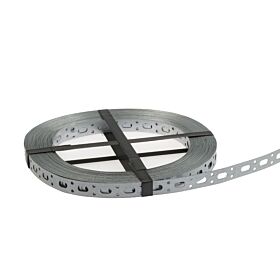A Fixing Band Is an Essential Item in Your Toolbox
Confined spaces, angled runs and suspended setups often require a mounting method that adapts to
irregular positioning. Fixing band fills this gap with predictable spacing for fasteners, minimal storage
volume and compatibility with uneven mounting points. On-site length adjustment allows support
across spans where pre-cut solutions fail. The punched layout helps with alignment during ceiling work
or wall routing, and reduces drilling effort in brittle materials. Project engineers rely on the material
when time, space or tolerances are limited. Frequently used to secure pipes or air ducts, the band
offers a reliable solution for both temporary and permanent configurations. As a fallback option during
last-minute changes, it belongs in any professional installer’s core equipment.
Benefits of Using a Pre-Galvanised Fixing Band
Fixing band is often used in situations where tolerances are unclear, mounting points are missing, or
measurements cannot be finalised before installation. This flexible strip gives installers full control over
positioning, length and tension without being restricted to predefined formats. The regular perforation
allows for quick adjustment on-site using standard tools. Supplied on a compact roll, the material is
easy to transport and can be reused in temporary configurations. Many professionals choose this
solution as a practical alternative to fixed brackets or clamps, especially when speed and adaptability
are more important than rigid precision. Often selected as an all-purpose fixing band in steel
installations where space or alignment is limited.
Tips for Installing a Fixing Band
Preparation
Before installation, measure the total length of fixing band needed and allow extra room for overlap
and secure fastening. Check whether the surface is wood, concrete or steel to select the right type of
fixings, such as plugs, screws or bolts. Use a tape measure and marker to define anchor points clearly
and maintain proper spacing. Plan the layout to avoid misalignment and make adjustments easier
during mounting. Place the anchors in a straight line to ensure pressure is evenly distributed along the
band. Careful preparation reduces installation time and leads to a more stable result.
Cutting the Fixing Band to Size
The fixing band should be cut to the required length using metal shears or a heavy-duty cutter. Mark
the cut point beforehand to keep the perforation holes aligned. Make one clean and steady cut to
avoid deformation. The edges may be sharp after cutting, so protective gloves are strongly
recommended.
Mounting the Fixing Band
Place the fixing band around or alongside the object and fasten the strip using screws, bolts or nails
through the perforated holes. Tension must be sufficient to hold the band in place without causing
deformation or surface damage. Start fastening from the centre and work outward to keep the tension
balanced across the band. On uneven or curved surfaces, adjust slightly to ensure full contact before
tightening completely.
Final Check
After installation, verify that the fixing band sits flush against the surface, without lifted sections or
unsecured ends. In applications exposed to vibration or repeated mechanical load, regular inspection
is essential. To increase load-bearing capacity, the band is often used in combination with mounting
brackets. For lightweight plastic pipework, plastic pipe clips may be more appropriate. Always fold
sharp cut ends inward or apply tape to prevent injury during use or maintenance.
Buisklem Delivers Steel Fixing Bands for HVAC, Cable Routing and Assembly Work Across
Europe
Buisklem supplies pre-galvanised fixing bands for installers and distributors who need flexible
mounting where brackets cannot be placed. The perforated steel strip is used to secure pipes, cable
ducts and structural components in heating systems, ventilation units and technical assemblies. Each
roll can be cut to length on site and mounted directly to walls, ceilings or support frames. Distribution
is tailored to professionals who rely on standard dimensions, clean roll edges and dependable supply
at the installation site.


